Unit - 4
Inheritance
In C++, inheritance is a process in which one object acquires all the properties and behaviors of its parent object automatically. In such way, you can reuse, extend or modify the attributes and behaviors which are defined in other class.
In C++, the class which inherits the members of another class is called derived class and the class whose members are inherited is called base class. The derived class is the specialized class for the base class.
Advantage of C++ Inheritance
Code reusability: Now you can reuse the members of your parent class. So, there is no need to define the member again. So less code is required in the class.
Types Of Inheritance
C++ supports five types of inheritance:
- Single inheritance
- Multiple inheritance
- Hierarchical inheritance
- Multilevel inheritance
- Hybrid inheritance
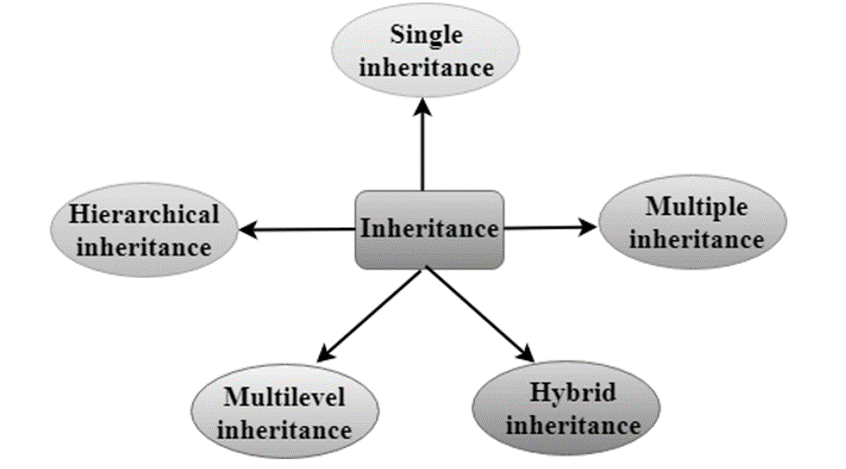
Derived Classes
A Derived class is defined as the class derived from the base class.
The Syntax of Derived class:
- Class derived_class_name :: visibility-mode base_class_name
- {
- // body of the derived class.
- }
Where,
Derived_class_name: It is the name of the derived class.
Visibility mode: The visibility mode specifies whether the features of the base class are publicly inherited or privately inherited. It can be public or private.
Base_class_name: It is the name of the base class.
- When the base class is privately inherited by the derived class, public members of the base class becomes the private members of the derived class. Therefore, the public members of the base class are not accessible by the objects of the derived class only by the member functions of the derived class.
- When the base class is publicly inherited by the derived class, public members of the base class also become the public members of the derived class. Therefore, the public members of the base class are accessible by the objects of the derived class as well as by the member functions of the base class.
Note:
- In C++, the default mode of visibility is private.
- The private members of the base class are never inherited.
C++ Single Inheritance
Single inheritance is defined as the inheritance in which a derived class is inherited from the only one base class.
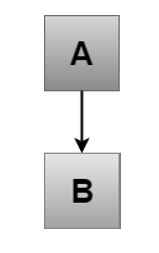
Where 'A' is the base class, and 'B' is the derived class.
C++ Single Level Inheritance Example: Inheriting Fields
When one class inherits another class, it is known as single level inheritance. Let's see the example of single level inheritance which inherits the fields only.
- #include <iostream>
- Using namespace std;
- Class Account {
- Public:
- Float salary = 60000;
- };
- Class Programmer: public Account {
- Public:
- Float bonus = 5000;
- };
- Int main(void) {
- Programmer p1;
- Cout<<"Salary: "<<p1.salary<<endl;
- Cout<<"Bonus: "<<p1.bonus<<endl;
- Return 0;
- }
Output:
Salary: 60000
Bonus: 5000
In the above example, Employee is the base class and Programmer is the derived class.
C++ Single Level Inheritance Example: Inheriting Methods
Let's see another example of inheritance in C++ which inherits methods only.
- #include <iostream>
- Using namespace std;
- Class Animal {
- Public:
- Void eat() {
- Cout<<"Eating..."<<endl;
- }
- };
- Class Dog: public Animal
- {
- Public:
- Void bark(){
- Cout<<"Barking...";
- }
- };
- Int main(void) {
- Dog d1;
- d1.eat();
- d1.bark();
- Return 0;
- }
Output:
Eating...
Barking...
Let's see a simple example.
- #include <iostream>
- Using namespace std;
- Class A
- {
- Int a = 4;
- Int b = 5;
- Public:
- Int mul()
- {
- Int c = a*b;
- Return c;
- }
- };
- Class B : private A
- {
- Public:
- Void display()
- {
- Int result = mul();
- Std::cout <<"Multiplication of a and b is : "<<result<< std::endl;
- }
- };
- Int main()
- {
- B b;
- b.display();
- Return 0;
- }
Output:
Multiplication of a and b is : 20
In the above example, class A is privately inherited. Therefore, the mul() function of class 'A' cannot be accessed by the object of class B. It can only be accessed by the member function of class B.
How to make a Private Member Inheritable
The private member is not inheritable. If we modify the visibility mode by making it public, but this takes away the advantage of data hiding.
C++ introduces a third visibility modifier, i.e., protected. The member which is declared as protected will be accessible to all the member functions within the class as well as the class immediately derived from it.
Visibility modes can be classified into three categories:

- Public: When the member is declared as public, it is accessible to all the functions of the program.
- Private: When the member is declared as private, it is accessible within the class only.
- Protected: When the member is declared as protected, it is accessible within its own class as well as the class immediately derived from it.
Visibility of Inherited Members
Base class visibility | Derived class visibility | ||
Public | Private | Protected | |
Private | Not Inherited | Not Inherited | Not Inherited |
Protected | Protected | Private | Protected |
Public | Public | Private | Protected |
C++ Multilevel Inheritance
Multilevel inheritance is a process of deriving a class from another derived class.
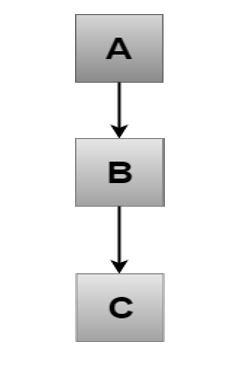
C++ Multi Level Inheritance Example
When one class inherits another class which is further inherited by another class, it is known as multi level inheritance in C++. Inheritance is transitive so the last derived class acquires all the members of all its base classes.
Let's see the example of multi level inheritance in C++.
- #include <iostream>
- Using namespace std;
- Class Animal {
- Public:
- Void eat() {
- Cout<<"Eating..."<<endl;
- }
- };
- Class Dog: public Animal
- {
- Public:
- Void bark(){
- Cout<<"Barking..."<<endl;
- }
- };
- Class BabyDog: public Dog
- {
- Public:
- Void weep() {
- Cout<<"Weeping...";
- }
- };
- Int main(void) {
- BabyDog d1;
- d1.eat();
- d1.bark();
- d1.weep();
- Return 0;
- }
Output:
Eating...
Barking...
Weeping...
C++ Multiple Inheritance
Multiple inheritance is the process of deriving a new class that inherits the attributes from two or more classes.
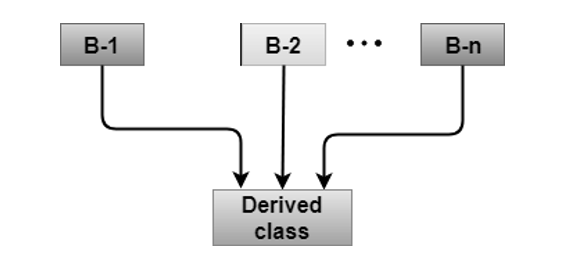
Syntax of the Derived class:
- Class D : visibility B-1, visibility B-2, ?
- {
- // Body of the class;
- }
Let's see a simple example of multiple inheritance.
- #include <iostream>
- Using namespace std;
- Class A
- {
- Protected:
- Int a;
- Public:
- Void get_a(int n)
- {
- a = n;
- }
- };
- Class B
- {
- Protected:
- Int b;
- Public:
- Void get_b(int n)
- {
- b = n;
- }
- };
- Class C : public A,public B
- {
- Public:
- Void display()
- {
- Std::cout << "The value of a is : " <<a<< std::endl;
- Std::cout << "The value of b is : " <<b<< std::endl;
- Cout<<"Addition of a and b is : "<<a+b;
- }
- };
- Int main()
- {
- C c;
- c.get_a(10);
- c.get_b(20);
- c.display();
- Return 0;
- }
Output:
The value of a is : 10
The value of b is : 20
Addition of a and b is : 30
In the above example, class 'C' inherits two base classes 'A' and 'B' in a public mode.
Ambiguity Resolution in Inheritance
Ambiguity can be occurred in using the multiple inheritance when a function with the same name occurs in more than one base class.
Let's understand this through an example:
- #include <iostream>
- Using namespace std;
- Class A
- {
- Public:
- Void display()
- {
- Std::cout << "Class A" << std::endl;
- }
- };
- Class B
- {
- Public:
- Void display()
- {
- Std::cout << "Class B" << std::endl;
- }
- };
- Class C : public A, public B
- {
- Void view()
- {
- Display();
- }
- };
- Int main()
- {
- C c;
- c.display();
- Return 0;
- }
Output:
Error: reference to 'display' is ambiguous
display();
The above issue can be resolved by using the class resolution operator with the function. In the above example, the derived class code can be rewritten as:
- Class C : public A, public B
- {
- Void view()
- {
- A :: display(); // Calling the display() function of class A.
- B :: display(); // Calling the display() function of class B.
- }
- };
An ambiguity can also occur in single inheritance.
Consider the following situation:
- Class A
- {
- Public:
- Void display()
- {
- Cout<<?Class A?;
- }
- } ;
- Class B
- {
- Public:
- Void display()
- {
- Cout<<?Class B?;
- }
- } ;
In the above case, the function of the derived class overrides the method of the base class. Therefore, call to the display() function will simply call the function defined in the derived class. If we want to invoke the base class function, we can use the class resolution operator.
- Int main()
- {
- B b;
- b.display(); // Calling the display() function of B class.
- b.B :: display(); // Calling the display() function defined in B class.
- }
C++ Hybrid Inheritance
Hybrid inheritance is a combination of more than one type of inheritance.

Let's see a simple example:
- #include <iostream>
- Using namespace std;
- Class A
- {
- Protected:
- Int a;
- Public:
- Void get_a()
- {
- Std::cout << "Enter the value of 'a' : " << std::endl;
- Cin>>a;
- }
- };
- Class B : public A
- {
- Protected:
- Int b;
- Public:
- Void get_b()
- {
- Std::cout << "Enter the value of 'b' : " << std::endl;
- Cin>>b;
- }
- };
- Class C
- {
- Protected:
- Int c;
- Public:
- Void get_c()
- {
- Std::cout << "Enter the value of c is : " << std::endl;
- Cin>>c;
- }
- };
- Class D : public B, public C
- {
- Protected:
- Int d;
- Public:
- Void mul()
- {
- Get_a();
- Get_b();
- Get_c();
- Std::cout << "Multiplication of a,b,c is : " <<a*b*c<< std::endl;
- }
- };
- Int main()
- {
- D d;
- d.mul();
- Return 0;
- }
Output:
Enter the value of 'a' :
10
Enter the value of 'b' :
20
Enter the value of c is :
30
Multiplication of a,b,c is : 6000
C++ Hierarchical Inheritance
Hierarchical inheritance is defined as the process of deriving more than one class from a base class.
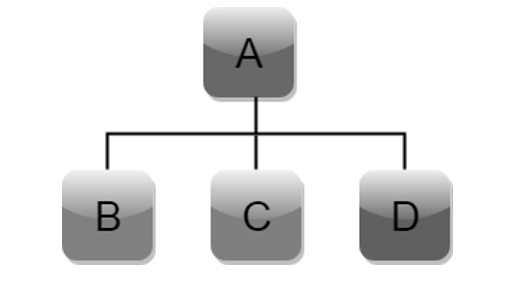
Syntax of Hierarchical inheritance:
- Class A
- {
- // body of the class A.
- }
- Class B : public A
- {
- // body of class B.
- }
- Class C : public A
- {
- // body of class C.
- }
- Class D : public A
- {
- // body of class D.
- }
Let's see a simple example:
- #include <iostream>
- Using namespace std;
- Class Shape // Declaration of base class.
- {
- Public:
- Int a;
- Int b;
- Void get_data(int n,int m)
- {
- a= n;
- b = m;
- }
- };
- Class Rectangle : public Shape // inheriting Shape class
- {
- Public:
- Int rect_area()
- {
- Int result = a*b;
- Return result;
- }
- };
- Class Triangle : public Shape // inheriting Shape class
- {
- Public:
- Int triangle_area()
- {
- Float result = 0.5*a*b;
- Return result;
- }
- };
- Int main()
- {
- Rectangle r;
- Triangle t;
- Int length,breadth,base,height;
- Std::cout << "Enter the length and breadth of a rectangle: " << std::endl;
- Cin>>length>>breadth;
- r.get_data(length,breadth);
- Int m = r.rect_area();
- Std::cout << "Area of the rectangle is : " <<m<< std::endl;
- Std::cout << "Enter the base and height of the triangle: " << std::endl;
- Cin>>base>>height;
- t.get_data(base,height);
- Float n = t.triangle_area();
- Std::cout <<"Area of the triangle is : " << n<<std::endl;
- Return 0;
- }
Output:
Enter the length and breadth of a rectangle:
23
20
Area of the rectangle is : 460
Enter the base and height of the triangle:
2
5
Area of the triangle is : 5
The term "Polymorphism" is the combination of "poly" + "morphs" which means many forms. It is a greek word. In object-oriented programming, we use 3 main concepts: inheritance, encapsulation, and polymorphism.
Real Life Example of Polymorphism
Let's consider a real-life example of polymorphism. A lady behaves like a teacher in a classroom, mother or daughter in a home and customer in a market. Here, a single person is behaving differently according to the situations.
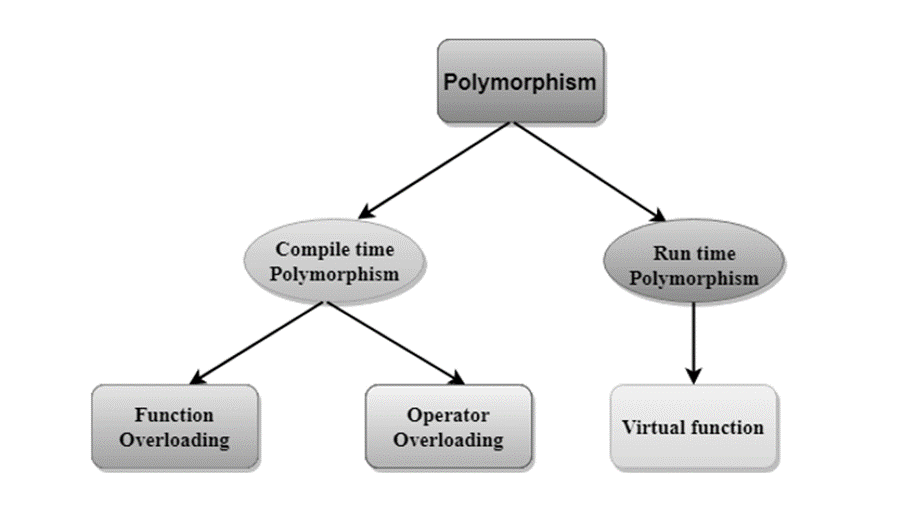
There are two types of polymorphism in C++:
- Compile time polymorphism: The overloaded functions are invoked by matching the type and number of arguments. This information is available at the compile time and, therefore, compiler selects the appropriate function at the compile time. It is achieved by function overloading and operator overloading which is also known as static binding or early binding. Now, let's consider the case where function name and prototype is same.
- Class A // base class declaration.
- {
- Int a;
- Public:
- Void display()
- {
- Cout<< "Class A ";
- }
- };
- Class B : public A // derived class declaration.
- {
- Int b;
- Public:
- Void display()
- {
- Cout<<"Class B";
- }
- };
In the above case, the prototype of display() function is the same in both the base and derived class. Therefore, the static binding cannot be applied. It would be great if the appropriate function is selected at the run time. This is known as run time polymorphism.
- Run time polymorphism: Run time polymorphism is achieved when the object's method is invoked at the run time instead of compile time. It is achieved by method overriding which is also known as dynamic binding or late binding.
Differences b/w compile time and run time polymorphism.
Compile time polymorphism | Run time polymorphism |
The function to be invoked is known at the compile time. | The function to be invoked is known at the run time. |
It is also known as overloading, early binding and static binding. | It is also known as overriding, Dynamic binding and late binding. |
Overloading is a compile time polymorphism where more than one method is having the same name but with the different number of parameters or the type of the parameters. | Overriding is a run time polymorphism where more than one method is having the same name, number of parameters and the type of the parameters. |
It is achieved by function overloading and operator overloading. | It is achieved by virtual functions and pointers. |
It provides fast execution as it is known at the compile time. | It provides slow execution as it is known at the run time. |
It is less flexible as mainly all the things execute at the compile time. | It is more flexible as all the things execute at the run time. |
C++ Runtime Polymorphism Example
Let's see a simple example of run time polymorphism in C++.
// an example without the virtual keyword.
- #include <iostream>
- Using namespace std;
- Class Animal {
- Public:
- Void eat(){
- Cout<<"Eating...";
- }
- };
- Class Dog: public Animal
- {
- Public:
- Void eat()
- { cout<<"Eating bread...";
- }
- };
- Int main(void) {
- Dog d = Dog();
- d.eat();
- Return 0;
- }
Output:
Eating bread...
C++ Run time Polymorphism Example: By using two derived class
Let's see another example of run time polymorphism in C++ where we are having two derived classes.
// an example with virtual keyword.
- #include <iostream>
- Using namespace std;
- Class Shape { // base class
- Public:
- Virtual void draw(){ // virtual function
- Cout<<"drawing..."<<endl;
- }
- };
- Class Rectangle: public Shape // inheriting Shape class.
- {
- Public:
- Void draw()
- {
- Cout<<"drawing rectangle..."<<endl;
- }
- };
- Class Circle: public Shape // inheriting Shape class.
- {
- Public:
- Void draw()
- {
- Cout<<"drawing circle..."<<endl;
- }
- };
- Int main(void) {
- Shape *s; // base class pointer.
- Shape sh; // base class object.
- Rectangle rec;
- Circle cir;
- s=&sh;
- s->draw();
- s=&rec;
- s->draw();
- s=?
- s->draw();
- }
Output:
Drawing...
Drawing rectangle...
Drawing circle...
Runtime Polymorphism with Data Members
Runtime Polymorphism can be achieved by data members in C++. Let's see an example where we are accessing the field by reference variable which refers to the instance of derived class.
- #include <iostream>
- Using namespace std;
- Class Animal { // base class declaration.
- Public:
- String color = "Black";
- };
- Class Dog: public Animal // inheriting Animal class.
- {
- Public:
- String color = "Grey";
- };
- Int main(void) {
- Animal d= Dog();
- Cout<<d.color;
- }
Output:
Black
- A C++ virtual function is a member function in the base class that you redefine in a derived class. It is declared using the virtual keyword.
- It is used to tell the compiler to perform dynamic linkage or late binding on the function.
- There is a necessity to use the single pointer to refer to all the objects of the different classes. So, we create the pointer to the base class that refers to all the derived objects. But, when base class pointer contains the address of the derived class object, always executes the base class function. This issue can only be resolved by using the 'virtual' function.
- A 'virtual' is a keyword preceding the normal declaration of a function.
- When the function is made virtual, C++ determines which function is to be invoked at the runtime based on the type of the object pointed by the base class pointer.
Late binding or Dynamic linkage
In late binding function call is resolved during runtime. Therefore compiler determines the type of object at runtime, and then binds the function call.
Rules of Virtual Function
- Virtual functions must be members of some class.
- Virtual functions cannot be static members.
- They are accessed through object pointers.
- They can be a friend of another class.
- A virtual function must be defined in the base class, even though it is not used.
- The prototypes of a virtual function of the base class and all the derived classes must be identical. If the two functions with the same name but different prototypes, C++ will consider them as the overloaded functions.
- We cannot have a virtual constructor, but we can have a virtual destructor
- Consider the situation when we don't use the virtual keyword.
- #include <iostream>
- Using namespace std;
- Class A
- {
- Int x=5;
- Public:
- Void display()
- {
- Std::cout << "Value of x is : " << x<<std::endl;
- }
- };
- Class B: public A
- {
- Int y = 10;
- Public:
- Void display()
- {
- Std::cout << "Value of y is : " <<y<< std::endl;
- }
- };
- Int main()
- {
- A *a;
- B b;
- a = &b;
- a->display();
- Return 0;
- }
Output:
Value of x is : 5
In the above example, * a is the base class pointer. The pointer can only access the base class members but not the members of the derived class. Although C++ permits the base pointer to point to any object derived from the base class, it cannot directly access the members of the derived class. Therefore, there is a need for virtual function which allows the base pointer to access the members of the derived class.
C++ virtual function Example
Let's see the simple example of C++ virtual function used to invoked the derived class in a program.
- #include <iostream>
- {
- Public:
- Virtual void display()
- {
- Cout << "Base class is invoked"<<endl;
- }
- };
- Class B:public A
- {
- Public:
- Void display()
- {
- Cout << "Derived Class is invoked"<<endl;
- }
- };
- Int main()
- {
- A* a; //pointer of base class
- B b; //object of derived class
- a = &b;
- a->display(); //Late Binding occurs
- }
Output:
Derived Class is invoked
Pure Virtual Function
- A virtual function is not used for performing any task. It only serves as a placeholder.
- When the function has no definition, such function is known as "do-nothing" function.
- The "do-nothing" function is known as a pure virtual function. A pure virtual function is a function declared in the base class that has no definition relative to the base class.
- A class containing the pure virtual function cannot be used to declare the objects of its own, such classes are known as abstract base classes.
- The main objective of the base class is to provide the traits to the derived classes and to create the base pointer used for achieving the runtime polymorphism.
Pure virtual function can be defined as:
Virtual void display() = 0;
Let's see a simple example:
- #include <iostream>
- Using namespace std;
- Class Base
- {
- Public:
- Virtual void show() = 0;
- };
- Class Derived : public Base
- {
- Public:
- Void show()
- {
- Std::cout << "Derived class is derived from the base class." << std::endl;
- }
- };
- Int main()
- {
- Base *bptr;
- //Base b;
- Derived d;
- Bptr = &d;
- Bptr->show();
- Return 0;
- }
Output:
Derived class is derived from the base class.
In the above example, the base class contains the pure virtual function. Therefore, the base class is an abstract base class. We cannot create the object of the base class.
References:
1. Object oriented programming By E. Balagurusamy.
2. C++ Programming –By D. Ravichandran
3. Let Us C++ By YashawantKanetkar.
4. Object Oriented Programming in C++ - Dr. G. T. Thampi, Dr. S. S. Mantha
5. Mastering C++ -By Venugopal.